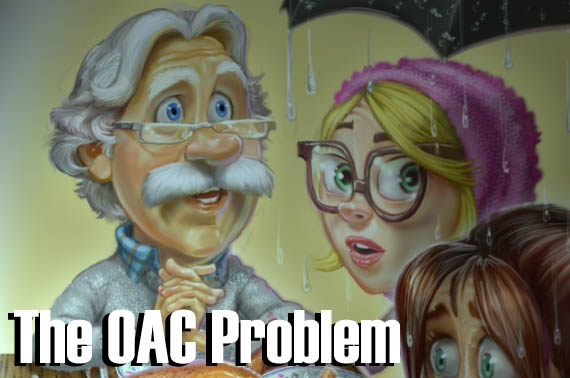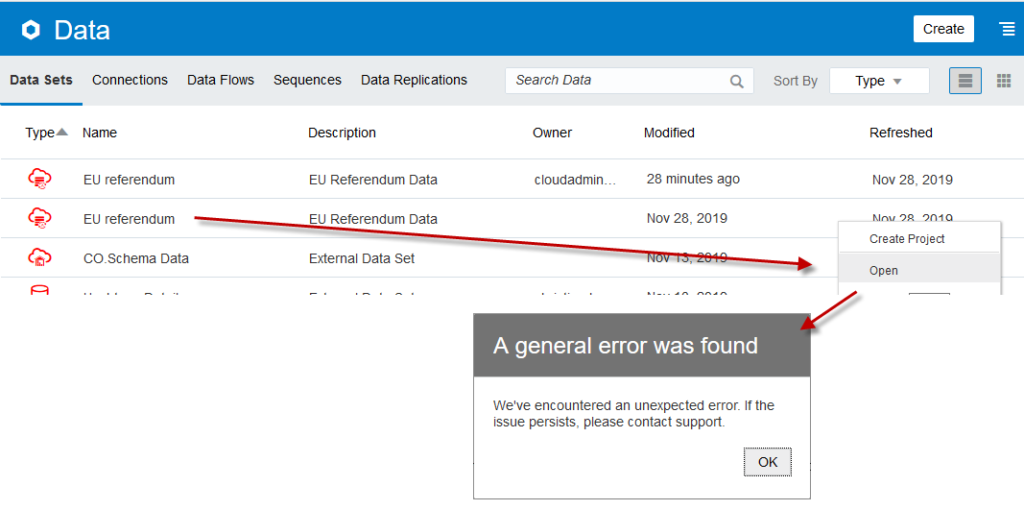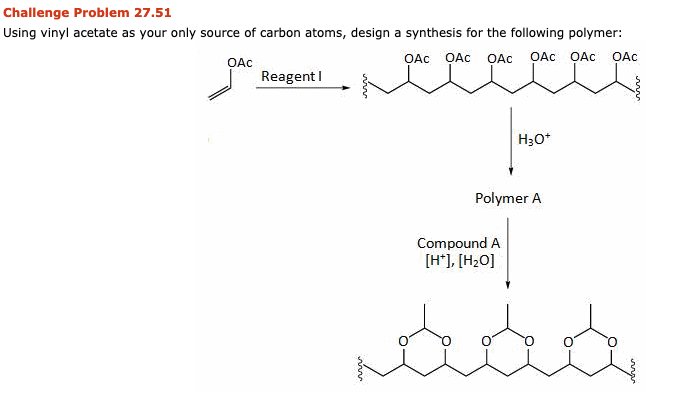Last week Oracle Analytics Cloud v105.4 was announced. One of the features particularly interested me since it reminded the story of an Italian couple willing to spend their honeymoon in the Australian Sydney and ending up in the same Sydney city but in Nova Scotia for a travel agency error. For the funny people out there: don't worry, it wasn't me!
Reporting an Accessibility Problem OAC is working to meet compliance with Oklahoma's EITA standards and Section 508 of the Rehabilitation Act. If you would like to report an accessibility problem with the OAC website, please email the OAC accessibility compliance representative. Obesity is a disease where a person’s weight is in an unhealthy range (BMI of 30.0-39.9). It is a disease that can lead to other health problems. Talk with your healthcare provider to better understand and treat obesity. Additionally, the config.sql executes without any errors. However, we are only seeing the 5 original channels in the OAC and not seeing any of the 'merged' channels in the OAC even though the channels are in the database. Set a PARTYID for all of the missing channels Problem summary. The Obesity Action Coalition (OAC) is a non-profit organization dedicated to giving a voice to individuals affected by the disease of obesity and helping them along their journey toward better health through education, advocacy and support. While I agree that fat shaming apps are a problem (though I don’t think they are nearly as much of a problem as partnering with the OAC) I think that a single point of agreement is not a good enough reason to create a partnership or even the appearance of one – I think we also have to consider downside risk.

The feature is 'Maps ambiguous location matches' and I wanted to write a bit about it.
#OracleAnalytics 105.4 update just about to go live and deploy on your environments. Check-out some of the new features coming. Here is a first list of selected items: https://t.co/Megqz5ekcx. Stay tuned with whole #OAC team (@OracleAnalytics,@BenjaminArnulf...) for more examples pic.twitter.com/CWpj8rC1Bf
— Philippe Lions (@philippe_lions) October 8, 2019Btw OAC 105.4 includes a good set of new features like a unified Home page, the possibility to customize any DV font and more options for security and on-premises connections amongst others. For a full list of new features check out the related Oracle blog or videos.
Maps: a bit of History
Let's start with a bit of history. Maps have been around in OBIEE first and OAC later since a long time, in the earlier stages of my career I spent quite a lot of time writing HTML and Javascript to include map visualizations within OBIEE 10g. The basic tool was called Mapviewer and the knowledge & time required to create a custom clickable or drillable map was....huge!
With the raise of OBIEE 11g and 12c the Mapping capability became easier, a new 'Map' visualization type was included in the Answers and all we had to do was to match the geographical reference coming from one of our Subject Areas (e.g. Country Name) with the related column containing the shape information (e.g. the Country Shape).
After doing so, we were able to plot our geographical information properly: adding multiple layers, drilling capabilities and tooltips was just a matter of few clicks.
The Secret Source: Good Maps and Data Quality

Perfect, you might think, we can easily use maps everywhere as soon as we have any type of geo-location data available in our dataset! Well, the reality in the old days wasn't like that, Oracle at the time provided some sample maps with a certain level of granularity and covering only some countries in detail. What if we wanted to display all the suburbs of Verona? Sadly that wasn't included so we were forced to either find a free source online or to purchase it from a Vendor.
The source of map shapes was only half of the problem to solve: we always need to create a join with a column coming from our Subject Area! Should we use the Zip Code? What about the Address? Is City name enough? The deeper we were going into the mapping details the more problems were arising.

A common problem (as we saw before about Sydney) was using the City name. How many cities are called the same? How many regions? Is the street name correct? Data quality was and still is crucial to provide accurate data and not only a nice but useless map view.
OAC and the Automatic Mapping Capability
The Aoc Problem
Within OAC, DV offers the Automatic Mapping Capability, we only need to include in a Project a column containing a geographical reference (lat/long, country name etc), select 'Map' as visualization type and the tool will choose the most appropriate mapping granularity that matches our dataset.
Great! This solves all our issues! Well... not all of them! The Automatic Mapping capability doesn't have all the possible maps in it, but we can always include new custom maps using the OAC Console if we need them.
So What's New in 105.4?
All the above was available way before the latest OAC release. The 105.4 adds the 'Maps ambiguous location matches' feature, which means that every time we create a Map View, OAC will provide us with a Location Matches option
If we click this option OAC will provide as a simple window where we can see:
- How many locations matched
- How many locations have issues
- What's the type of Issue?
The type of issue can be one between:
No Matchin case OAC doesn't find any comparable geographical valueMultiple Matcheswhen there are multiple possible associationsPartial Matcheswhen there is a match only to part of the content
We can then take this useful information and start a process of data cleaning to raise the quality of our data visualization.
Conclusion
Maps were and are a really important visualization available in OAC. The Maps ambiguous location matches feature provides a way to understand if our visualization is representative of our dataset. So, if you want to avoid spending your honeymoon in the wrong Sydney or if you just want to provide accurate maps on top of your dataset, use this feature available in OAC!
A committee of visitors (COV), chaired by Dr. Robin Bell, was convened in Autumn of 2001 to review the polar research support services (PRSS) of OPP and to recommend areas where logistics and infrastructure, supporting scientific research in Antarctica, could be expanded or improved. The OAC extends its appreciation to Dr. Bell for the effort in providing an informative report that captures the important issues to which continued attention should be paid. The overall message of the COV report—that OPP provides the national scientific community with an extraordinary polar-research infrastructure, unsurpassed in its capacity to foster innovative, technologically modern investigation in all areas of scientific interest—was well-received and echoed by OAC discussion in November, when we reviewed the report. Indeed, the OAC takes this opportunity to applaud OPP for creating a world-class research infrastructure in one of the world's least explored and most extreme environments. We acknowlege the enormous challenges inherit to this overall task and both the general (e.g., long-term planning, according to scientific input) and specific (short-term fuel savings) ways by which OPP and PRSS achieve this success. We also commend the attention to circumstances where logistics and support resources can be shifted without adverse effect from areas considered 'well established' to areas of 'innovation,' thus helping to keep Antarctic research at the cutting edge.
The COV report speaks for itself in articulating six major recommendations for OPP to consider in continuing to build and maintain this remarkable scientific support infrastructure. After spirited discussion and debate, the OAC accepts these recommendations for the most part. However, OAC members took issue with COV conclusions on at least one major recommendation (#1); we elaborate our views on this recommendation and two others below.
Recommendation 1.'Streamline the logistics planning process.' We recognize that the ultimate capacity of OPP to fund and support individual proposals involves two categories of consideration. The first one, scientific merit, is covered by an extensive review process (involving two criteria) that involves mail reviews, panel reviews and the collective wisdom of OPP program managers. The second category, logistical support impact, presently is covered by a detailed review, by PRSS top-level management and by the science support contractor, Raytheon Polar Services (RPS), of all proposals; i.e., regardless of proposal status relative to the scientific merit consideration. The thrust of the COV recommendation is to address the fact that this detailed initial review of all proposals puts an undue time burden on PRSS and RPS staff, who must typically deploy to the Antarctic within 3 or 4 months of the proposal submission deadline. The OAC is sympathetic to the problems associated with achievement of a logistical review process that includes all proposals under the given time constraints. We most strongly recommend, however, that any 'streamlining' efforts to remedy these problems be developed in such a manner as to:
- avoid either the real or perceived circumstance that deliberation on whether to fund or decline an individual proposal is compromised by administrative preconceptions based on logistic support considerations made in advance of a full review of the scientific merit of the proposal; and
- avoid streamlining steps that might ultimately limit innovation in either scientific research or logistical support practices; i.e., research proposals that are 'easy to support' given present infrastructure should not automatically take precedence in funding over proposals that might be 'difficult to support' due to their innovative nature.

Recommendation 2.'Take a leadership role in implementing the Antarctic Environmental Protocol.' The wording of this recommendation implies that OPP is not currently providing leadership in implementing the Antarctic Environmental Protocol. The OAC recognizes and commends the fact that OPP is already providing exemplary leadership in this area. An accurate wording for this COV recommendation is 'Continue to provide strong leadership in implementing the Antarctic Environmental Protocol.'
Recommendation 3.'Upgrade deep-field science infrastructure.' While PRSS should consider many initiatives as means to upgrade deep-field science support, one of the principal constraints felt sharply by deep-field scientists is the lack of sufficient C130 aircraft support, as duly noted elsewhere in the COV report. The present insufficiency of C130 flight hours devoted to deep-field support is due largely to the South Pole station reconstruction efforts, which we recognize to have a finite lifetime. (We also recognize that PRSS has worked hard and successfully to ensure that the disruption to science by the reconstruction efforts was less extreme than originally anticipated by the Augustine report). Nevertheless, the OAC believes that the best way to allow science priorities to drive deep-field research forward is to continue to increase the number of on-continent LC-130 missions devoted to deep-field science support even during the remaining years of reconstruction work. Two ways to increase the availability of these flights would be to: 1) extend the functionality of the Pegasus runway (used for wheeled, intercontinental missions); and 2) investigate over-snow traverses to re-supply South Pole Station. These measures may free ski-equipped LC-130 resources for science tasking.
The Pac Problem
In considering the overall impact of logistics constraints on scientific research in Antarctica, the OAC recognizes both the opportunities and drawbacks of large research projects (such as IceCube); they have the potential to expand scientific frontiers, but at significant logistic impact to other parts of the OPP mission. Such projects must include both science and logistics components in their budget, including funding for acquisition of new support capabilities if needed. In considering the prospects of new, single-item 'large science' research in Antarctica, OPP should continue to be vigilant in its effort to ensure that the overall capability to support broadly based scientific research by the 'community at large' is not affected adversely.
The OAC also anticipates obstacles to continuing and improving the excellence and innovation of Antarctic research in the form of absent modern communications and internet access from South Pole, the Dry Valleys, and Deep Field sites. Until these sites are covered by continuous, reliable, high-bandwidth voice and data links, certain types of research cannot be fully effective or even undertaken. Some examples include astrophysical research at South Pole (high-volume data transmission needs), extended season/over-winter research in the Dry Valleys (voice and data links for health and safety), and remote, autonomous geophysical and meteorological research (two-way, near-real-time, medium bandwidth data).